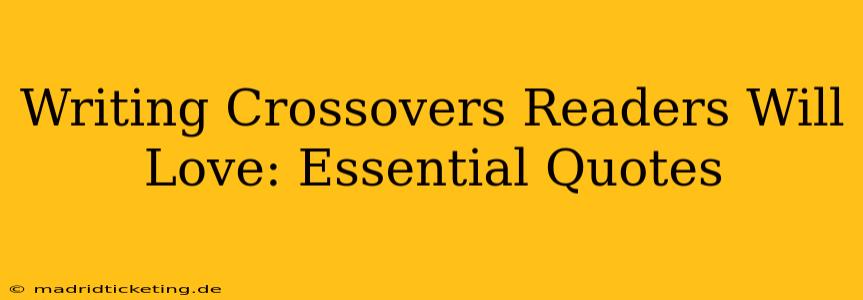Crossovers. The very word conjures images of beloved characters from different worlds colliding, sparking new adventures and unexpected friendships (or rivalries!). But crafting a crossover that truly resonates with readers requires more than just throwing favorite characters into a blender. It demands careful planning, a deep understanding of each source material, and a deft touch in weaving together disparate narratives. This article explores the essential quotes that can help guide you in creating a crossover readers will adore, focusing on elements of character, world-building, and plot. We'll also tackle some frequently asked questions to provide you with a comprehensive guide.
What Makes a Successful Crossover?
A successful crossover isn't just about fan service; it's about creating a compelling story that honors the source material while forging something new and exciting. This involves:
-
Respecting the Source Material: Understanding the nuances of each universe – their tone, themes, and characterizations – is crucial. A jarring mismatch in tone can derail even the most ambitious crossover.
-
Creating Compelling Conflict: The clash of different worlds should naturally lead to compelling conflict. This could be a misunderstanding, a philosophical difference, or a full-blown battle.
-
Developing Organic Interactions: The interactions between characters shouldn't feel forced. They should stem from their personalities and the unique situations presented by the crossover.
Essential Quotes to Guide Your Crossover Writing
Here are some key quotes and concepts that can provide a framework for your crossover writing, inspiring you to create something truly special:
"The best stories are those that ask more questions than they answer." – Anonymous
This quote highlights the importance of leaving room for mystery and intrigue in your crossover. Don't feel the need to explain everything immediately. Let the reader discover the intricacies of the combined universes at their own pace.
"It is not enough to be different. Others must also recognize the difference." – Anonymous
This is crucial for character interactions. The differences between the characters from different universes need to be clear and meaningful, impacting the plot and relationships.
"The only limit to our realization of tomorrow will be our doubts of today." – Franklin D. Roosevelt
Don't be afraid to experiment and push boundaries. Embrace the possibilities of blending different worlds, and trust your creative instincts. A successful crossover will surprise and delight readers, and it starts with your willingness to take risks.
"The true alchemists do not change lead into gold; they change the world into words." – William H. Gass
The essence of a good story is translating the richness of the worlds and the characters into captivating prose that draws the reader in.
Frequently Asked Questions about Crossovers
How do I avoid making my crossover feel forced or inauthentic?
The key is to establish a logical reason for the characters to interact. Perhaps a shared enemy, a mysterious artifact, or a dimensional rift brings them together. Organic interactions are essential; they should naturally arise from the characters' personalities and the circumstances of the story.
How do I balance the needs of fans of each source material?
It’s a tightrope walk. You need to satisfy the expectations of fans of both worlds while creating something new and exciting. Consider incorporating elements that appeal to both audiences, but don't be afraid to challenge expectations and subvert tropes.
How can I ensure my crossover is original and avoids clichés?
Thorough research and a fresh perspective are key. Don't just replicate elements from the source material. Instead, use them as inspiration to create something unique. Find unexpected connections between the worlds and characters.
What are some common mistakes to avoid when writing a crossover?
- Ignoring the source material's tone and style: This can lead to inconsistencies and a jarring reading experience.
- Over-relying on fan service: While fan service can be a good thing, it shouldn't overshadow the story itself.
- Failing to create a compelling plot: The crossover needs a strong central conflict to keep readers engaged.
- Poorly developed character interactions: The characters' interactions should feel natural and believable, rather than forced or contrived.
By carefully considering these quotes and addressing the common pitfalls, you can craft a crossover that not only delights fans but also creates a compelling and unique reading experience. Remember, the ultimate goal is to tell a great story that transcends the individual source materials.

